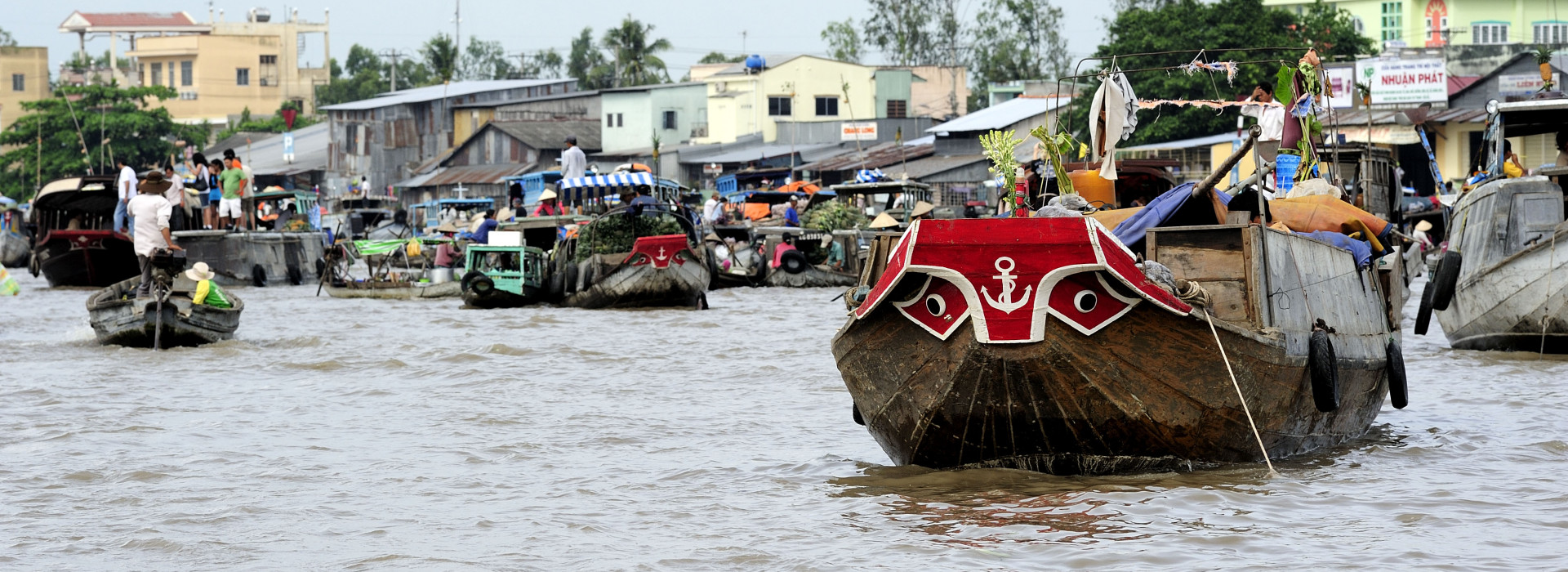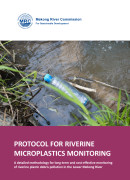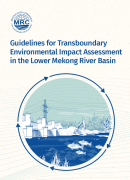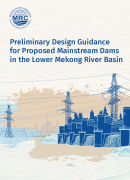
Navigation
For thousands of years, the Mekong River has served as the main transport route between riparian towns situated along its banks. It provides a means for people to access natural resources and social facilities, such as schools and health services. Traditional forms of trade linking communities continue today; however, the river is playing an increasingly important role in international trade routes, connecting the six Mekong countries to each other and to the rest of the world.
Main cargo transported between Thailand’s Chiang Saen and China is mostly the refined petroleum products from Bangkok, which is 32% of the throughput. The other 68% is transported by road. The Phnom Penh cargo throughput to Viet Nam in 2014 is 140,000 twenty-foot equivalent unit (TEU). The cargo transported between Viet Nam and Cambodia includes petroleum, general cargo, cement, steel, coal, fertilizers, and agriculture products.
Additionally, passenger transport along the Mekong River makes a great contribution to tourism development with thousands of tourists from China, Thailand and Lao PDR. 1,800 passenger tourist boats are registered in Lao PDR while there are many big inland and seagoing vessels of up to 5,000-ton deadweight (DWT) are registered in Cambodia and Viet Nam.
Despites the income and employment opportunities the trade brings, the navigation potential of the river is still under-utilised. Navigation conditions vary greatly along its length. The upper parts of the Khone Falls in southern Lao PDR contain a number of physical obstacles and turbulent sections. Only experienced skippers and boats that are small in size, shallow of draught, and no more than 45m in length can safely navigate the Mekong in its current condition.
Waterway improvements in the upper stretches of the river require the rocky outcrops to be removed or relocated. Improvements are expected to make the river passable for much larger cargo boats, which will boost both regional and international exchange of goods. However, reckless removal of the obstacles could impact the flow of the river, resulting in lowering the water table upstream while raising it downstream.
According to the MRC Council Study’s assessment, economic gains from the navigation sector increased by $69 billion by 2014, a ten-fold increase over the past 24 years. However, increased inland traffic has the potential to cause significant pollution, such as oil spills from shipping accidents and major incidents such as fires and explosions, all of which could impact riparian communities.
The MRC’s work in navigation derives from the Mekong Agreement’s article 9 on freedom of navigation. Specifically, the MRC supports countries through:
- Basin-wide strategies and plans as the Master Plan on Waterborne Transport that promote navigation, connectivity and waterborne trade
- MRC Procedures including the Prior Consultation process that ensures all mainstream projects have good navigation locks that facilitates freedom of navigation
- Agreements between countries that facilitate rules-based waterborne transport
- Guidelines and tools that facilitate navigation safety
- Studies and assessments of benefits and costs of navigation as part of larger studies
Since the first agreement on Mekong cooperation was signed in 1957, the riparian countries have entered into various forms of navigation agreements.
Following the Mekong Agreement that established the MRC in 1995, the MRC Navigation Strategy (2003) facilitated negotiations between the Member Countries to improve navigation conditions, including the removal of non-physical barriers and the improvement of safety and efficiency.
Through its Navigation Programme, the first Agreement on Waterway Transport between Cambodia and Viet Nam was formulated to reduce cross-border navigation restrictions, and improve efficiency and safety standards.
Under the strategic cycle 2011-2015, the MRC Navigation Programme coordinated surveys for improving traffic on the Mekong River system, including along the Mekong, Tonle Sap, Vam Nao, and Bassac Rivers. The Programme also developed Electronic Navigation Charts (ENCs) of the Mekong, Vam Nao, and Bassac Rivers in Viet Nam, which can be used by modern vessels with onboard computer-based navigation information systems. In addition, the Programme conducted studies encompassing waterway channels, buoys and beacons, standard specifications for ship locks for hydropower development, and modern standards for passenger jetties.
Under the Basin Development Strategy (BDS) 2016-2020, the MRC continues to stress the importance of investing in the waterborne transport sector to attract investment and realize additional regional trade potential through implementation of: (i) a Master Plan for Regional Waterborne Transport in the Mekong River Basin (Volume I and II); (ii) the Regional Action Plan for Dangerous Goods; (iii) the Agreement between Cambodia and Vietnam on Waterway transport; and (iv) navigation safety and anti-pollution rules for Lao PRD and Thailand.
The Master Plan for Regional Waterborne Transport in the Mekong River Basin, known as the Navigation Master Plan, is a short-term and long-term development programme that aims to improve the national and international transport network by providing information on the actual situation for waterborne transport on the Mekong River. It includes economic assessments and forecasts, development scenarios, and an action plan, including ongoing and planned projects for the short-term (2020) and long-term future (2040). The plan takes into consideration other agreements pertaining to the river, including China’s Plan for International Navigation on the Lancang-Mekong, to avoid conflict and contribute to the elimination and mitigation of rock-blasting activities.
The Regional Action Plan for Sustainable Transport of Dangerous Goods, published in 2014, is devoted to traffic safety and environmental sustainability. It promotes environmental standards for "clean" river transport, balancing the environmental consequences of projects against their economic and social benefits to ensure the ecological health of the river is not compromised. The plan consists of national and cross-border project documents to serve as a basis to reduce the risk of accidents, pollution, and enhance emergency response and regional coordination.
Implementation of the Agreement on Waterway Transport between Cambodia and Viet Nam is supported by the establishment and operation of the Bilateral Mekong Navigation Facilitation Committee (MNFC). Both countries are expected to take steps toward harmonising rules and regulations, which will further contribute to the development of navigation on the Mekong River.
Inspired by the MRC Master Plan for Waterborne Transport in the Mekong River Basin, the Thai Mekong Navigation Committee has developed a joint plan with Lao PDR for the preparation of safety regulations. The MRC supports the two countries to prepare regulations safety instruments.
Under the BDS 2021-2030 and MRC Strategic Plan 2021-2025, the MRC continues to coordinate the implementation of the Navigation Master Plan, including by selecting most relevant actions aligning with national projects of the Member Countries , preparing detailed activities of the selected actions, and assisting the Member Countries in the implementation.
Although Inland barges can offer an economical, environmentally-friendly, and safe mode of transport, significant challenges remain.
The MRC study, the Carriage, Handling and Storage of Dangerous Goods (Volume I), reveals that a number of inland ports and terminals have limited capacity in the management of dangerous goods, waste management, environmental protection, and emergency response planning. Furthermore, awareness and understanding of the treatment of dangerous goods in port management and worker safety needs to be enhanced. The study (Volume II) provides recommendations calling for ports to implement management systems for handling dangerous goods, environmental protection, and emergency and oil spill response.
The Council Study on navigation assessment examines the transboundary impacts of existing and planned navigation infrastructure on river flow (quantity, quality, timing, and content) including an assessment of the positive and negative impacts of water resources developments in other thematic areas on navigation. Key findings from the study concluded that:
- There will be a positive economic and social impact from navigation development. By 2040, it is expected that 89 million tons of cargo will be shifted from road to inland waterway transport, providing job opportunities for 1.95 million people.
- Navigation will have a negligible impact on water flow quantity, timing and content, assuming that dredged material is dumped back into the river to maintain the hydrological and sediment balance.
- Hydropower development will mostly have positive impact to navigation enhancement in the Mekong.
The river’s water is currently of good quality. However, the water risks bearing the brunt of waste and chemicals discharged from expanding industrial and urban activities. The transport of dangerous cargo could result in additional negative effects on the environment. To help the Member Countries manage these risks, the MRC has developed the following guidelines:
- Waste Management Guidelines for Chiang Saen Commercial Port Area: The guidelines aim to reduce and eliminate the illegal dumping of waste into the marine environment. Protection of the marine environment can be enhanced significantly by reducing discharges of ship-generated waste and cargo residues. The guidelines also provide a framework on how to prepare waste management manuals for specific ports. The involvement of port management and all relevant stakeholders in the development of efficient waste management systems is recommended.
- Mekong Vessel Inspection Scheme: The scheme consists of a vessel inspection checklist and guidebook. The scheme is intended to assist vessel operators, crews, and authorities in assessing the safety of a vessel’s construction, equipment, and operation.
- The Guidelines for the storage and handling of dangerous goods: The guidelines outline the relevant criteria and management systems for handling dangerous goods. It includes risk assessments for activities and operations at Chiang Saen Commercial Port, including port operations and vessel management.
The MRC has produced a series of knowledge products, including strategies, guidelines and studies mentioned above, to facilitate decision-making and stimulate innovation for the sustainable management and development of navigation systems.


